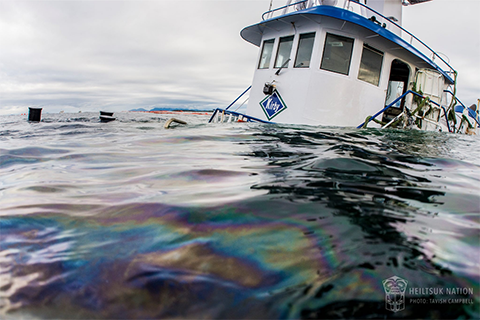David Suzuki's Blog, page 25
October 27, 2016
David Suzuki Foundation welcomes fisheries updates
VANCOUVER -- The David Suzuki Foundation applauds the federal government's decision to make information about Canada's major fish stocks and fisheries available to the public for the first time.
"After many years of advocating for greater public access to information, we're encouraged to see the government putting this information online," said Foundation senior research scientist Scott Wallace.
Fisheries and Oceans Canada's website now includes yearly updates about fisheries management for 159 major fish stocks, ranging from stock status and bycatch to lost gear and species at risk. "For too long we've been unable to access our government's assessment of how well they're managing Canada's fisheries. This information will help not only scientists but also the fishing industry and other stakeholders to make better decisions to improve fisheries," Wallace said.
Stepping up actions to make information about fisheries and fish health more available also responds to concerns about information gaps raised earlier this year by Commissioner of the Environment and Sustainable Development Julie Gelfand. The commissioner's audit was unable to find health information for more than half of Canada's major fish stocks. In addition, 15 major fish stocks were found to be in critical condition and still being fished, with no rebuilding plans for 12 of them.
"Canadians care about the health of our oceans and our country's ability to sustainably manage marine resources. Now they can use this knowledge to work constructively with decision-makers, better understand the issues and complexities of fisheries management and engage as concerned citizens to protect fish in their communities," Wallace said.
Fisheries and Oceans Canada Sustainability Survey for Fisheries: http://www.dfo-mpo.gc.ca/fm-gp/peches-fisheries/fish-ren-peche/sff-cpd/survey-sondage/index-en.html
- 30 -
Media contacts:
Scott Wallace, Senior Research Scientist, David Suzuki Foundation
778-558-3984
Theresa Beer, Senior Communications Specialist, David Suzuki Foundation
778-874-3396
Hey! Want more DSF? Join David Suzuki on Facebook

October 25, 2016
Write a letter to the editor to ban oil tanker traffic on the B.C. North Coast
October 20, 2016
Food security is important for humans and other animals
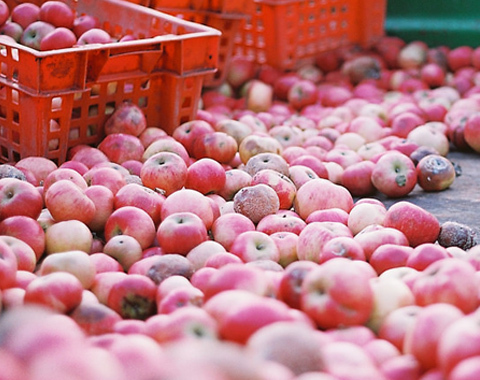
(Credit: Laura Thorne via Flickr)
As leaves change colour and drop from trees, and a chill in the air signals the approach of winter, many of us are thinking of the fall harvest and hearty soups and dishes that will soon warm our bellies.
Not everyone is lucky enough to enjoy such thoughts. About four million Canadians -- including more than a million children -- lack food security, defined as reliable access to a sufficient quantity of affordable, nutritious food. In Canada, people from low-income households and Indigenous communities are the most likely to suffer from food insecurity.
Fruit, vegetables and other fresh food must often be flown into remote Indigenous communities, leading to alarmingly high sticker prices that make healthy diet choices unaffordable. A 2016 report by Food Secure Canada found the average monthly cost to feed a family of four in three remote northern reserve communities of Fort Albany, Attawapiskat and Moose Factory is $1,793.40, based on 67 standard food items (the Revised Northern Food Basket), and that on-reserve households in Fort Albany must spend at least half their median monthly income on a basic nutritious diet.
Food insecurity takes on an even starker meaning in the community of Grassy Narrows, Ontario. In the 1960s, the provincial government allowed a pulp and paper company to dump more than 10 tonnes of mercury into the Wabigoon River system. Despite recent science showing it can be cleaned up, the government has refused calls to remedy the situation. Toxic mercury levels still exist in the watershed. It travels up the food chain, bioaccumulating in fish that Grassy Narrows community members rely on for subsistence. Consumption of toxic fish has resulted in high rates of mercury poisoning, affecting not only community members' food choices but also their rights to carry out traditional livelihoods.
Sadly, it's not just humans who are affected by mismanagement of food systems and the ecosystems of which they are a part. Wildlife feel the impacts as well. The primary threats of habitat loss and degradation faced by some of Canada's at-risk species are compounded by food insecurity.
Take the monarch butterfly. Its caterpillars' sole food source is milkweed, yet milkweed has long been eradicated in Canada as a noxious weed. (It was only removed from the noxious weed list in Ontario, its main migration thoroughfare in Canada, in 2013.) Milkweed scarcity is even worse in the American Midwest's corn belt, where herbicide-tolerant corn and soy crops treated with glyphosate (Roundup), have all but eliminated the plants from vast swaths of land that once provided an essential food source for monarchs.
According to Monarch Watch, since 1996, 29.5 million acres of land not previously used for agricultural purposes were put into corn and soybean production. In 2007, the U.S. Congress passed the Clean Energy Act, creating a market for ethanol. The demand for corn spiked to an all-time high. Farmers pulled land out of conservation and planted corn wherever they could. Corn is also used to feed livestock, especially hogs and poultry, which is then eaten by us.
The impacts of our harvesting and consumption patterns on land are mirrored in the ocean. This year's sockeye salmon run in B.C. was the lowest in recorded history. Salmon, enjoyed by many of us and an essential food source for many Indigenous communities, are also a staple for numerous wildlife species, including bears, eagles and whales. This year's low salmon numbers led to the closure of commercial and First Nations fisheries on the important Fraser River sockeye run. South Coast chinook had similarly poor returns. Beyond what this means for salmon fishers and Indigenous communities, 82 endangered southern resident killer whales depend on chinook salmon to survive.
Globally, social justice organizations such as Oxfam note that human hunger is not and need never be inevitable. It's caused by poverty and inequality, not scarcity.
We produce more than enough to feed all people on the planet. Surely it's one of the fundamental challenges of our time to focus our considerable intelligence on altering our consumption and harvesting patterns so that all who share this small blue Earth -- two-legged, four-legged, winged and finned -- can enjoy food security.
Hey! Want more DSF? Join David Suzuki on Facebook
October 19, 2016
How to make all-purpose scour
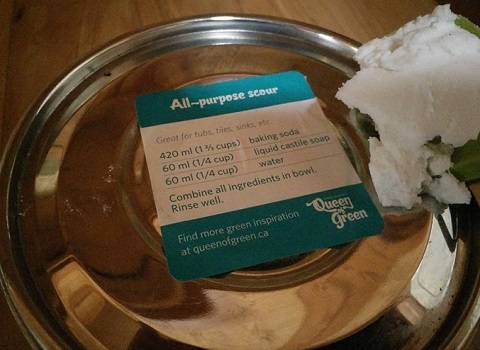
You'll need five minutes to make a batch of this nontoxic home cleaner which will last up to six months! (Credit: Lindsay Coulter)
This DIY "green" cleaning recipe is one of my one of my top nine. It works to clean tubs, tiles and sinks. And it's so safe, kids can clean, too. (My three-year-old begs to scrub the tub!)
All-purpose scour recipe
Time needed: five minutes
Shelf life: approximately six months
420 ml (1 2/3 cups) baking soda
60 ml (¼ cup) liquid castile soap (scented or unscented)
60 ml (¼ cup) water
Combine all ingredients in a stainless steel bowl. Stir until the mixture is the consistency of whipped cream. Use immediately, or store in a labelled, air-tight container. Rinse well.
Note: Use reusable produce bags to buy baking soda in bulk. Choose liquid castile soap that does not contain palm oil.
I use peppermint liquid castile soap for all my cleaning recipes. I find the scent uplifting when I'm doing un-fun chores.
Toss a dollop of this scour in the toilet and rub vigorously with a toilet brush. If bathroom mould and mildew is a problem, try these three solutions.
How have you used this recipe? Share your review in the comments below.
Sincerely,
Lindsay Coulter, a fellow Queen of Green
Hey! Want more DSF? Join David Suzuki on Facebook
October 18, 2016
David Suzuki Foundation response to Saskatchewan climate plan
The Saskatchewan government's goals to advance carbon capture and storage and renewable energy require a well-designed price on carbon emissions to be fully achievable. In his speech today, Premier Brad Wall identified both carbon pricing and innovation as two of the three approaches -- along with adaptation -- that governments can take to address climate change. It is important to acknowledge, however, that all three of these approaches are critical for an effective climate change strategy. Deploying clean technologies without putting a price on carbon pollution is like trying to start a canola farm without planting seeds.
The world's leading economic experts have concluded that it is critical to set a price on carbon emissions through a carbon tax or a regulatory cap to reduce greenhouse gas emissions, as this economic signal will spur development and diffusion of clean energy and energy-efficiency technologies to replace polluting ones. A strong price on carbon emissions through a cap-and-trade system or a carbon tax incentive is needed to make Saskatchewan's plans to deploy clean, renewable energy technologies a reality. Putting a price on carbon pollution is an essential foundation for an effective climate change strategy.
Premier Wall is absolutely correct in his assessment of innovation and renewable energy being critical to global action on climate change. But a price on carbon pollution, rather than standing in the way of these technologies, is the key to unlock their potential. Properly applied, a price on carbon will cut Saskatchewan's carbon emissions, clean and diversify its energy sector and put thousands of residents to work in reliable jobs in the renewable energy industry -- one of the fastest-growing industries in the world, and one that is far less volatile than commodity-based energy markets.
- 30 -
For more information, contact:
Steve Kux, David Suzuki Foundation
Phone: 604-374-4102
Hey! Want more DSF? Join David Suzuki on Facebook
October 14, 2016
Choose reusable produce bags
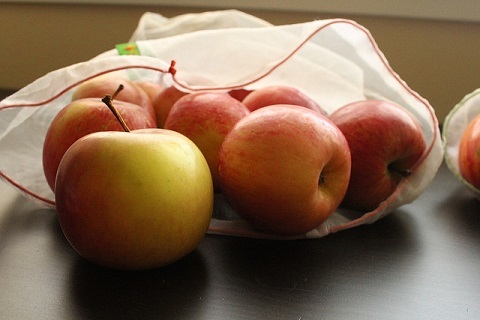
Reusable produce bags are also great for bulk dry goods like nuts, seeds and beans. (Credit: Kate Fisher via Flickr)
You tote reusable shopping bags to the store. Now bring a few eco-friendly, fabric produce bags along, too.
These lightweight drawstring bags are often sold in sets of three. They make it easy for the cashier to weigh your items AND for you to carry and organize produce at home. They're washable, reusable, come in a variety of sizes and styles and the stretchy kind can carry a lot of stuff. They're also an excellent way to stop using plastic -- even paper -- produce bags.
Buy reusable produce bags at your local grocery or zero waste store, or online. DIYers can also sew their own or repurpose T-shirts (no sewing required).
The benefits of refusing plastic produce bags:
The world doesn't need more plastic (we've already made plastic islands)
Recycling plastic bags isn't the answer
Grocery stores are going zero waste; we should, too
Other uses for reusable produce bags
Pack your lunch inside (easy for kids to open)
Shop for bulk dry goods like nuts, seeds, beans and flours
Keep a fine mesh bag over your countertop fruit bowl to lock out fruit flies
Where do you buy reusable produce bags? What else do you use them for?
Sincerely,
Lindsay Coulter, a fellow Queen of Green
Hey! Want more DSF? Join David Suzuki on Facebook
Choose reusable bags

Reusable produce bags are also great for bulk dry goods like nuts, seeds and beans. (Credit: Kate Fisher via Flickr)
You tote reusable shopping bags to the store. Now bring a few eco-friendly, fabric produce bags along, too.
These lightweight drawstring bags are often sold in sets of three. They make it easy for the cashier to weigh your items AND for you to carry and organize produce at home. They're washable, reusable, come in a variety of sizes and styles and the stretchy kind can carry a lot of stuff. They're also an excellent way to stop using plastic -- even paper -- produce bags.
Buy reusable produce bags at your local grocery or zero waste store, or online. DIYers can also sew their own or repurpose T-shirts (no sewing required).
The benefits of refusing plastic produce bags:
The world doesn't need more plastic (we've already made plastic islands)
Recycling plastic bags isn't the answer
Grocery stores are going zero waste; we should, too
Other uses for reusable produce bags
Pack your lunch inside (easy for kids to open)
Shop for bulk dry goods like nuts, seeds, beans and flours
Keep a fine mesh bag over your countertop fruit bowl to lock out fruit flies
Where do you buy reusable produce bags? What else do you use them for?
Sincerely,
Lindsay Coulter, a fellow Queen of Green
Hey! Want more DSF? Join David Suzuki on Facebook
October 13, 2016
We can't dig our way out of the fossil fuels pit
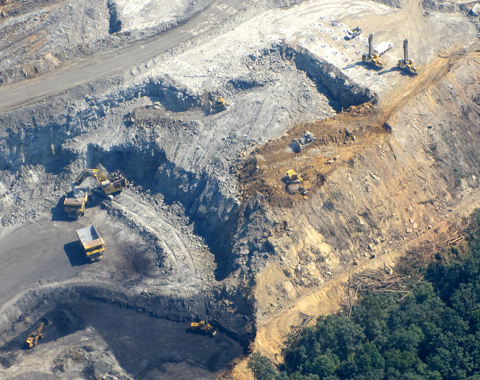
(Credit: Delta Whiskey via Flickr)
I've often thought politicians inhabit a parallel universe. Maybe it's just widespread cognitive dissonance, coupled with a lack of imagination, that compels them to engage in so much contradictory behaviour. Trying to appease so many varying interests isn't easy.
Rather than focusing on short-term economic and corporate priorities, though, politicians should first consider the long-term health and well-being of the people they're elected to represent. When it comes to climate change and fossil fuels, many aren't living up to that.
We celebrate the federal government's decision to implement nation-wide carbon pricing, even though what's proposed won't, without additional measures like regulations, get us to our commitments under the Paris Agreement, which is also inadequate for keeping global warming from catastrophic levels. A government could be forgiven for going slow on a measure opposed by some industrial sectors, provinces and citizens, but it's difficult to take a government seriously when it approves or supports expanding fossil fuel infrastructure and development while the world continues to break warming records, with increasingly dire consequences.
A massive B.C. "carbon bomb" LNG project in the midst of critical salmon-rearing territory, in defiance of many area First Nations' wishes. Likely approval of at least one more bitumen pipeline to support expanded oil sands development. A provincial government that pretty much says, "We'll support federal efforts to fight climate change if you support our efforts to fuel it." None of this makes sense.
As a report from non-profit Oil Change International and 14 other groups concludes, "The potential carbon emissions from the oil, gas, and coal in the world's currently operating fields and mines would take us beyond 2°C of warming," and "The reserves in currently operating oil and gas fields alone, even with no coal, would take the world beyond 1.5°C." That's without any new development!
That leaves us with three choices: managed decline, stranded assets or climate chaos. The first, which the report recommends, means no new fossil fuel infrastructure, existing supplies become depleted and replaced with clean alternatives and employees redeployed to latter. As the report's authors point out, "This does not mean stopping using all fossil fuels overnight. Governments and companies should conduct a managed decline of the fossil fuel industry and ensure a just transition for the workers and communities that depend on it."
Stranded assets means, "Companies continue to develop new fields and mines, governments are eventually successful in restricting emissions, and the resulting reduction in demand causes many extraction assets to become uneconomic and shut down, causing destruction of capital and large job losses."
Under the third scenario, we keep digging, mining, fracking, building, transporting, selling and burning until we're well beyond the 2 C threshold, resulting in "economic and human catastrophe."
Sadly, in Canada and globally, we've chosen the second option, and in some cases, the third. Subsidies to the fossil fuel industry, the most profitable industry ever, continue despite a 2009 G20 commitment to phase them out. Canada alone promotes the industry to the tune of about $3.3 billion a year in tax breaks and handouts, not including provincial incentives. Politicians say they care about climate while arguing we need more bitumen, natural gas and coal to fuel growing economies and human populations, and more pipelines to get "product" to tidewater and overseas markets. Saskatchewan has Canada's best wind and solar resources, but the government focuses on expensive and unreliable schemes like carbon capture and storage while arguing against carbon pricing and other tools to cut emissions.
It's all a form of denial. Conserving energy, shifting to cleaner sources, reducing automobile use by improving transit and bike and pedestrian infrastructure, protecting and restoring carbon sinks such as forests and wetlands, and getting a handle on agricultural emissions are all possible, and would create numerous jobs and economic opportunities.
Most national governments have committed to the 2015 Paris Agreement's goal of limiting global warming to 2 C above pre-industrial levels, with an aspirational goal of 1.5 C. We're already nearing the latter, with growing consequences, including increasing extreme weather events, water and food shortages, migration crises and extinctions. We must conserve energy, quickly phase out coal power and continue to develop renewable resources.
As Oil Change International says, "If you're in a hole, stop digging."
Tell the government to take real action to stop climate change
Hey! Want more DSF? Join David Suzuki on Facebook
Public can help end B.C.'s grizzly bear hunt with new toolkit
VANCOUVER -- More than 90 per cent of British Columbians oppose the province's annual grizzly bear trophy hunt. A new toolkit released today by the David Suzuki Foundation and University of Victoria's Environmental Law Centre will help the public participate in government decisions regarding the hunt. It provides information on how hunting decisions are made by government bureaucrats, such as the release of grizzly hunting tags and quotas and a calendar highlighting dates when these decisions are made so the public can intervene in an effective and timely way.
"The B.C. government manages the grizzly bear hunt behind closed doors and without oversight. We developed this toolkit to change that and to help concerned citizens better understand how the government runs the trophy hunt and how they can help stop it," said the David Suzuki Foundation's director for Ontario and Northern Canada and grizzly bear policy expert, Faisal Moola.
Independent bear biologists continue to express concerns that too many grizzly bears are being killed in the province and that the government is not doing enough to reduce mortality. The toolkit outlines how people can help by pressuring the B.C. government to reduce the number of hunting tags issued to trophy hunters and to close areas to trophy hunting. Government records show that 289 grizzly bears were killed in 2015, including in the Great Bear Rainforest, which was officially designated part of the Queen's Commonwealth Canopy Network by Prince William on a recent visit to the pristine region.
First Nations banned trophy hunting in the Great Bear Rainforest out of concern for the species. "It's not a part of our culture to kill an animal for sport and hang it on a wall," said Jessie Housty, a councillor with the Heiltsuk Nation. "When we go hunting it's for sustenance purposes, not trophy hunting," she added.
Environmental Law Centre legal director Calvin Sandborn said involving the public in government decisions is critical if we are to succeed in protecting wildlife. "First Nations and the public have information, expertise and wisdom that can enrich government decisions. Government needs to hear -- and heed -- British Columbians who want to restrict the trophy hunt. This toolkit will make that possible," Sandborn said.
B.C.'s auditor general is currently reviewing the grizzly bear hunt and other government policies related to grizzlies.
- 30 -
Media contacts:
Faisal Moola, David Suzuki Foundation
Phone: 647-993-5788
Theresa Beer, David Suzuki Foundation
Phone: 778-874-3396
Calvin Sandborn, UVic Environmental Law Centre
Phone: 250-472-5248
Hey! Want more DSF? Join David Suzuki on Facebook
October 12, 2016
Legal toolkit: Facilitating public participation in grizzly bear hunt management in British Columbia

This toolkit produced by the University of Victoria's Environmental Law Centre on behalf of the David Suzuki Foundation helps the public participate in government decisions regarding the grizzly bear trophy hunt. Legal toolkit: Facilitating public participation in grizzly bear management in British Columbia, provides information on how hunting decisions are made by government bureaucrats, such as the release of grizzly hunting tags and quotas and a calendar highlighting dates when these decisions are made so the public can intervene in an effective and timely way.
Hey! Want more DSF? Join David Suzuki on Facebook
David Suzuki's Blog
- David Suzuki's profile
- 247 followers


